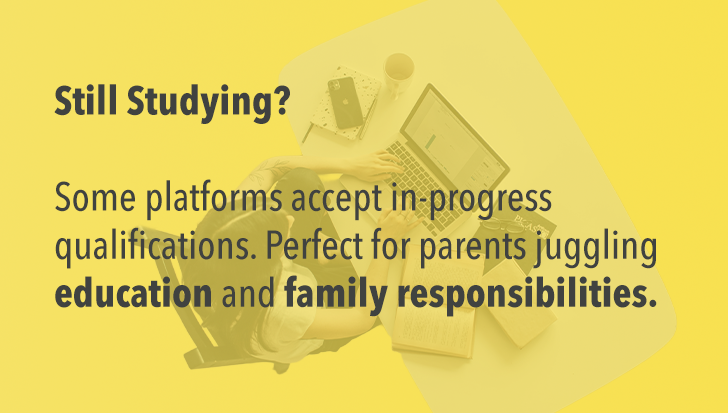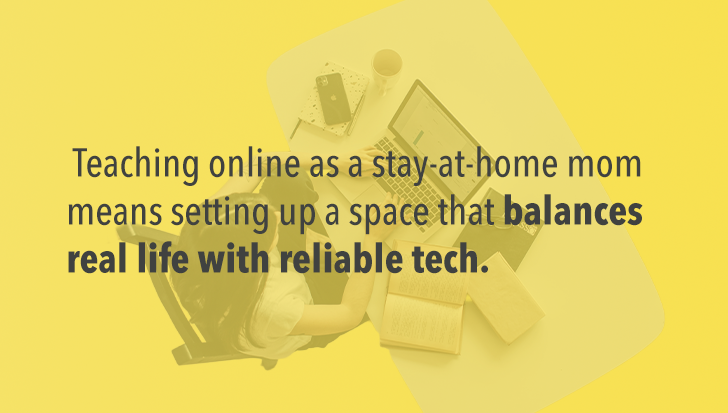You're a stay-at-home mom (SAHM), juggling kids, bills, and chaos, with a few quiet hours each day. You need work that bends around your reality, not a rigid nine-to-five that ignores nap time and math homework. Teaching English online delivers: flexible hours, solid pay in US dollars, and zero commute.
Just you, your laptop, and the skills you already have. You set the hours that work for your family — early morning, school time, or after bedtime. This guide is for stay-at-home moms who want to earn real money and keep their sanity.
I teach at 5 am before my twins wake up. By 7 am, I'm clocked out and ready for breakfast.
Sam, mom of two.
Why Teach English Online as a Stay-at-Home Mom?
Remote work is bliss for new mothers. Teaching English online is one of the few legit work-from-home jobs that doesn’t involve selling to friends or buying into a scheme.
01
Work From Home (WFH) = More Family Time
Teaching online means you can earn money without leaving your kids or your home. You’re present for first steps, homework help, and bedtime stories.
No office politics — you teach right from your home office or kitchen table and still make it to school pickup.
02
Set Your Own Hours
You're in control. Online teaching platforms run 24/7. Choose:
- Early-bird slots before the kids wake up.
- Mid-morning sessions during school hours.
- Evening classes after bedtime.
There's always someone ready to learn when you have time to teach. Use the table below to determine when the student's schedules work for your daily routine.
Peak Weekday Teaching Hours (Local ⇄ South Africa)
| Region | Student peak (local) | South African time (GMT +2) |
|---|---|---|
| China – Beijing | 6pm — 10pm | 12pm — 4pm |
| Japan |
7:10am — 9:10am 5:30pm — 10:30pm |
12am — 2am 10:30am — 3:30pm |
| Europe (CET) | 6pm — 9pm | 7pm — 10pm |
| South America | 6pm — 9pm | 10pm — 1am |
| South Korea |
6am — 9am 6pm — 12am |
11pm — 2am 10am — 10pm |
"As a mom and online teacher, I've learned to juggle lesson plans with school schedules and virtual classes with snack and dinner time. But the best part is getting to see my kids grow up and being there for the milestones - it's a privilege to have this flexibility, and it's what makes the chaos worth it."
Really Great Teacher Demi

03
Get Paid in USD
Most platforms pay in US dollars. For moms outside the US, the stronger currency stretches further at home.
04
Career Continuity
"Online ESL Instructor" looks better on your resume than a multi-year gap. You're building skills while prioritizing family.
05
Clear Boundaries
Unlike freelance projects that creep into family time, classes have a hard start and stop. When your session ends, you're done. No project emails haunting your evening, no deadlines bleeding into weekend plans.
06
Your Parenting Skills Are Actual Qualifications
Some platforms hire beginners and offer training, lesson plans, and support to varying degrees. As a parent, you’ve already mastered patience, multitasking, and explaining things in 10 different ways - that’s what teaching is.
“Teaching online gave me the gift of time with my 5-year-old son. I was finally able to be there for the little moments; his laughter, his curiosity, his quiet ways of connecting (that I used to miss). It's time I'll always treasure.”
Really Great Teacher Maria
How to Get Started Teaching English Online as a Stay-at-Home Mom
Ready to turn your parenting skills into paid work? Here's your roadmap to getting started.
Step 1: Get Your 120-Hour TEFL Certification
This is an essential, minimum requirement. 99% of ESL jobs require a 120-hour TEFL certification, and countries like China mandate it. Complete the online course at your own pace to fit around your parenting schedule.
Why You Need It:
- Proves you can teach English to non-native speakers.
- No TEFL certificate means your application won't even be considered.
- Covers the essentials in methods like TPR (Total Physical Response) and virtual classroom management, so you can teach online with confidence.
What You'll Learn:
- Proven teaching methods (not just winging it).
- Effective lesson planning.
- How to handle different student types.
Skip the free certificates. Invest in accredited programs that platforms accept. Your time matters — don't waste weeks on worthless qualifications that will be rejected.
Step 2: A Tertiary Qualification
A three-year diploma or bachelor's degree—any major—checks the qualification box. In South Africa, a National Diploma is usually the minimum requirement.
Your Field Doesn't Matter:
- Psychology? You understand how minds work.
- Business? You communicate professionally.
- Art? You think creatively.
Still Studying? Some platforms accept in-progress qualifications. Perfect for parents juggling education and family responsibilities.
Step 3: Native-Level English Fluency
If you speak non-accented English at a native or near-native level, you're in. Schools want C2-level proficiency, which you'll demonstrate through your intro video - smile, speak clearly, and show energy. That calm, friendly voice you use explaining bedtime rules works wonders here.
Step 4: A Clean Criminal Record
This is standard when working with students who are often minors. If you're in South Africa, apply for a Police Clearance Certificate (PCC) through your local South African Police Service (SAPS) office. Processing can take six weeks, so start early and track your application online.
Step 5: Start Building Teaching Experience
Some platforms hire beginners and offer training, lesson plans, and support to varying degrees. As a parent, you’ve already mastered patience, multitasking, and explaining things in 10 different ways - that’s what teaching is.
Experience Counts: Homeschooling, tutoring neighborhood kids, or volunteering as a teacher all strengthen your application. Highlight it!
Your 10-Week Launch Timeline:
- Weeks 1-2: Enroll in a TEFL course and apply for a police clearance.
- Weeks 3-7: Finish your TEFL; copy diploma; set up tech and workspace.
- Weeks 8-9: Record intro video; craft resume and cover letter; apply.
- Week 10+: Start teaching; gather student reviews; tweak schedule.
Your parenting experience isn't a career gap - it's specialized training for the global education market.

Finding The Right ESL Teaching Platform as a Stay-at-Home Parent
As a parent juggling family life, you need teaching work that fits your reality. Some platforms want a rigid schedule. Others expect you to hustle like it's a side business. There are four main paths to finding work as an online English teacher:
- Online ESL companies
- Online marketplaces
- Freelance or Independent
- The Really Great Teacher Company
Each has pros, cons, and a different level of flexibility. Your time and energy are limited, so the platform you choose needs to work for you, not against you.
"To our students we are 'teacher', but we are also women of many hats. My favorite role is being a mother. Being an online teacher allows me the flexibility to be away from my 7 month old for the least amount of time possible, while still earning a much needed secondary income for my home. Gone are the days when a husband could be the sole provider of the home. Online teaching allows me to fulfil my duties as a wife and mother, while bringing home the bacon and cooking it, too!”
Really Great Teacher Chenel
1) Online ESL Companies
Best for moms who are new to teaching, want structure, and prefer not to create their own lesson plans.
These structured companies sometimes provide everything needed — curriculum, students, tech platforms, and support. Your job? Show up and teach.
How It Works
- You apply, do an interview, and teach demo lessons.
- If hired, you're given a fixed schedule, curriculum, and regular students.
- You're paid per class as an independent contractor.
Pros for Teachers
- Predictable schedule: Easy to plan around your family's routine.
- Reduced prep needed: You will still need to prepare for each lesson, however time spent is reduced when material is provided.
- Admin-free Teaching: No chasing students or payments.
- Beginner-friendly: Great for building confidence without extra pressure.
Cons for Teachers
- Less flexibility: You can't easily cancel or change your schedule.
- No growth path: You're stuck at entry level with no advancement.
- Nationality bias: Some companies aren't open to hiring South Africans.
2) Online Teaching Marketplaces (like Cambly, Preply, iTalki)
Best for moms who want freedom to set their hours, rates, and teaching style. Think Uber for tutoring. You create a profile, set your rates, and compete for students on platforms where they book lessons directly with you.
How It Works
- You sign up, build your teaching profile, record an intro video, and set your availability.
- You market yourself to students based on your profile and teaching niche.
- The platform takes 15-30% commission but handles payments and provides the teaching space.
Pros for Teachers
- Complete schedule control: Teach when you want, cancel when needed.
- Set your rates: Charge more for specialized lessons.
- Teach your way: No set curriculum. Bring your own style.
Cons for Teachers
- Income uncertainty: No guaranteed students can mean unpredictable monthly earnings.
- Self-promotion: You'll need to hustle to build a student base.
- Platform fees: They take up to 30% of your earnings. Even worse, some platforms keep 100% of your demo lesson payments, so you teach for free while they pocket the money.
- Platform dependency: Rule changes can kill your income overnight.
- Price competition: Other teachers may undercut your rates to steal students.

3) Independent Teaching
Best for moms who are ready to build a brand and keep 100% of their earnings. Start your own tutoring business, market yourself, set your own rates, and work directly with students. Maximum freedom, maximum responsibility.
How It Works
- You're the CEO of your own teaching company.
- You build your teaching brand.
- You develop your own lessons, find students, and manage your schedule.
- You collect payments directly (e.g., PayPal, bank transfer).
Pros for Teachers
- Total autonomy: Complete control over schedule, rates, and teaching methods.
- Maximum earnings: Keep 100% of student payments.
- Specialization pays: Niche skills (e.g., IELTS prep, business English) mean higher rates.
- Build something lasting: Create a business that could outlast your parenting years.
Cons for Teachers
- Overwhelming responsibilities: Marketing, admin, and teaching while managing family life.
- Inconsistent income: Feast or famine, depending on your business skills.
- Steep learning curve: Must master marketing, accounting, and business operations.
- No safety net: Client cancellations directly impact the family budget.
- Time-consuming: Non-teaching tasks can eat into your day.
4) The Really Great Teacher Company
Best for moms seeking a hybrid option - offering a balance of structure and flexibility. The Really Great Teacher Company connects teachers to global students across time zones. It offers more freedom than traditional ESL companies, but with the support and structure that marketplaces and independent work often lack.
How It Works
- You apply once and join a vetted teaching network. It matches you with students from multiple schools around the world - kids, adults, and professionals. You can work part-time or full-time, depending on your schedule.
- Choose availability that fits your family routine.
- Get training, tech support, and access to lesson plans.
- Join a real community of teaching parents and peers.
- Earn in USD with structured pay and consistent hours.
Pros for Teachers
- Balanced flexibility: More schedule control than ESL companies and more stability than marketplaces. Ideal for stay-at-home mothers (SAHMs) with limited but predictable work hours.
- Steady income in USD: Teach students regularly without constantly pitching yourself. You can also teach on other platforms to fill your schedule when you have extra time.
- Professional development: Growth opportunities while maintaining family priorities. Access to their Inspire Academy and professional development tools means you're always learning.
- Community support: Through their Evolve program, you'll have access to monthly lifestyle and wellness events - perfect if you crave adult conversation and connection.
Cons for Teachers
- Moderate salary: You'll earn more than with entry-level ESL companies but less than teaching independently. Consider it a trade-off for consistency and support.
- Schedule commitment matters: Missing scheduled classes can lead to reduced hours or penalties. If your home life is unpredictable, this structure may feel too rigid at times.
Which Path Fits You Best?
| Platform Type | Best For | Biggest Pro | Biggest Con |
|---|---|---|---|
| Online ESL Companies | Moms who want stability | Pre-set curriculum & steady work | Fixed schedules & lower pay |
| Marketplaces (e.g., Cambly) | Moms who want control and flexibility | Set your schedule & rates | Unpredictable bookings & platform fees |
| Independent Teaching | Moms with time to build a business | Keep 100% of your earnings | Lots of admin and self-marketing |
| The Really Great Teacher Company | Moms needing balance | Reliable income + support | Moderate pay rate |
Setting Up Your Home Teaching Studio: Parent Edition
Your space doesn’t have to be perfect - it just needs to work. Teaching online as a stay-at-home mom means setting up a space that balances real life with reliable tech. It’s about quiet and distraction-free, not fancy. Students rank your lesson quality.
Tech Essentials for Teaching with Kids Around

You don't need an elaborate studio. But you do need the right gear to avoid mid-lesson meltdowns. Here's what matters most:
- A Solid Laptop or PC: Opt for at least an Intel Core i5 processor, 8GB of RAM, and a 2.0 GHz processor. Phones and tablets won’t pass interviews.
- HD Webcam (2MP or higher): Students need to see clear facial cues, not a pixelated blur from 2015.
- Noise-Canceling Headphones with Microphone: Kids yelling in the background mid-lesson? Quality headphones block household chaos from reaching your students, while a mute button becomes your emergency escape when things get loud.
- Fast and Reliable Internet: 20+ Mbps in both directions. Your internet speed is tested during the interview. Run a check at speedtest.net.
- Ethernet cable: Wi-Fi cuts out. Cables don't. This simple switch prevents 90% of connection disasters.
- Mobile hotspot: Use your phone's data when the internet fails. 1 GB covers approximately ten 25-minute lessons.
Companies and students understand occasional disruptions, but if it's a pattern, it will cost you jobs, income, and bookings.
The South African Load Shedding Survival Plan
In South Africa, load shedding kills more teaching careers than bad accents. Here's your defense strategy:
- Invest in a UPS system: a 2000VA unit keeps your setup running for 4-5 hours. No power = no pay.
- Portable power station: More expensive but longer-lasting option.
- Plan ahead: Check EskomSePush and schedule around blackout times when possible.
Designing a Parent-Friendly Teaching Zone

No extra room? No problem. Your teaching space can be a corner of the living room, a cleared-off dining room table, or even your bedroom - as long as it is quiet, distraction-free, and student-focused.
- Good Lighting: A simple desk lamp or ring light positioned behind your screen helps your students see your face clearly, which is crucial for language learning.
- Noise control: Choose your quietest room. Close doors and use towels to absorb sound. Let your little ones know that "teaching time = quiet time."
- Comfortable setup: An ergonomic chair and proper desk height help prevent fatigue during back-to-back classes.
- Simple Background: A white, blank background is best – mobile whiteboard, neutral wall, or even seamless linen such as a curtain or sheet.
- Secure the Kids: Set up a safe play space nearby (think: playpen, tablet time, or a snack station). Knowing they're entertained helps you stay focused.
- Emergency backup plan: Have activities ready in case your child needs attention during class.
- Professional response: If interruptions occur, it's best to deal with them in a manner that doesn't affect the student experience - such as asking for quiet while on mute.
“Teaching online from home has allowed me to stay present for my children while still doing meaningful work. It gave me the flexibility to grow professionally without sacrificing precious family time - truly the best of both worlds.”
How to Teach English Online with Kids at Home
Teaching online with children around, particularly if they are still young, can be done, but would require some planning and a great support system.
Find Your Quiet Windows
Work with your existing routine. Many moms teach:
- Early mornings (before kids wake up)
- Nap time
- After bedtime
Start with short sessions and adjust. Even 25-minute classes can work.
Set Boundaries (Even If They're Soft)
Create a teaching corner—even if it's a shared space.
Teach: "Headset on = Mom's working."
Use visual cues, such as a door sign, to signal "Mom's working." Toddlers won't read signs, so have snacks, a favorite toy, or a screen-time backup ready.
Plan Ahead, But Expect Chaos
Kids are bound to interrupt - enter each class prepared with an appropriate response plan for any situation. Students should never know if your surroundings are being disruptive; task them with an exercise while you very quickly address your children off-camera and on mute.
Get Family on Board
If you have a partner, older children, or extended family, ask for help during class times. Treat your schedule like real work - it helps others take it seriously, too.
Start Small, Then Stack
Short classes are easier to manage at first. Two 25-minute classes feel more manageable than a single 50-minute class. Once you find a rhythm — or backup support — you can take on more.
Find Mom Support Networks
Look for Facebook groups or forums with online teaching moms. You'll find ideas, real talk, and tips that help to make it work for you.
Reality check: No setup is perfect. However, with a bit of structure, realistic goals, and support, you can balance teaching and motherhood—and sometimes even enjoy both at the same time.

"As a mom, teaching online has made my life so much easier because I am able to run the house smoothly, while also attending to my job. I especially enjoy the possibility of being fully present and involved in my kid's lives every single day. It's so satisfying to work while knowing that I don't have to worry about going to the office and leaving them behind."
Really Great Teacher Jane
Ready to Start?
You already possess the most valuable skill sets: patience and multitasking. Finish your TEFL. Record your intro video. Test your headset tonight. The world is full of students waiting for a calm, encouraging teacher, exactly the person motherhood has trained you to be.
Turn nap time into a payday. You've got this.
